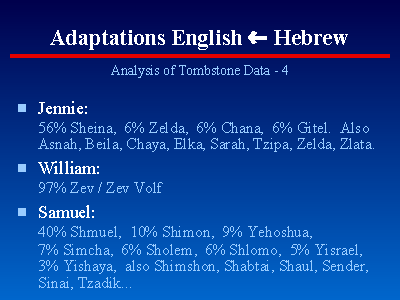 |
 |
Some final examples from my tombstone study. Note that the new American name could be based upon any of the immigrant's Hebrew or Yiddish names. More often, it was the Yiddish name, the secular name, that was the basis for the American name.
For example, of those that took the American name 'William', 97% had the Hebrew name 'Ze'ev'. Why? Because the Yiddish calque of 'Ze'ev' is 'Wulf' -- 'Wulf' was the everyday secular name that they were known by in Europe. The name 'Wulf' has a phonetic similarity to 'William' (the names have the letters 'w' and 'l' in similar positions), so most 'Wulf's became 'William' in America.
Of those that took the American name 'Sam' or 'Samuel', 40% had the Hebrew name 'Shmuel' (the language equivalent name), while 60% had other Hebrew names, including Shimon (10%), Yehoshua (9%), Simcha (7%), Sholem (6%), Shlomo (6%), Yisrael (5%), Yishaya (3%), as well as smaller percentages with many other Hebrew names, the majority starting with the letter 'S'. Note that in some of the above cases, it is the Yiddish diminutive name (such as Shea for Yehoshua, Srul for Yisrael, and Shaya for Yishaya) that has the common initial sound or letter with the new American name.